Investing in Central Utility Stocks - Do Today’s Valuations Make Sense?
Companies / US Utilities Aug 07, 2012 - 02:58 AM GMT This is the third in my series on investing in utility stocks based on the sector’s current valuation levels. The series was initially inspired by concerns that utility stocks may be overvalued because they had recently performed very well. When the series first started with Part 1, utility ETF’s were showing the best one-year performance of any sector. By the second installment Part 2, the utility sector had fallen into second place (Utility Sector Performance July 31, 2012). Since that time, utilities have fallen into fifth place with year-to-date performance of only 3.8% (see Utility Sector Performance August 3, 2012 below), this could be an indication that utilities are reaching full value.
This is the third in my series on investing in utility stocks based on the sector’s current valuation levels. The series was initially inspired by concerns that utility stocks may be overvalued because they had recently performed very well. When the series first started with Part 1, utility ETF’s were showing the best one-year performance of any sector. By the second installment Part 2, the utility sector had fallen into second place (Utility Sector Performance July 31, 2012). Since that time, utilities have fallen into fifth place with year-to-date performance of only 3.8% (see Utility Sector Performance August 3, 2012 below), this could be an indication that utilities are reaching full value.
Utility Sector Performance July 31, 2012
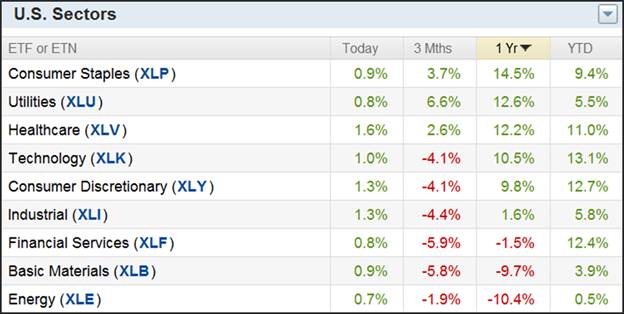
Utility Sector Performance August 3, 2012
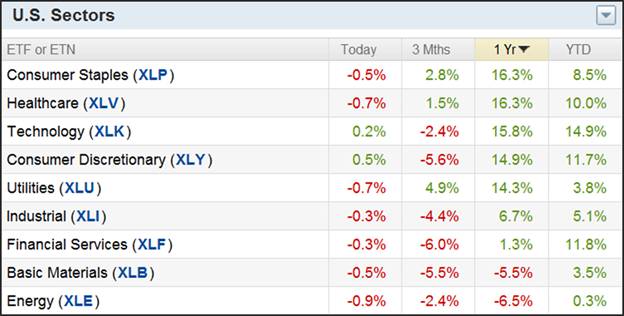
Central Utilities - A Review of Valuation
The following table compares the valuations of the major Central utility stocks utilizing the F.A.S.T. Graphs™ portfolio review tool. The first two columns compare each company’s current PE ratio to the PE ratio that the market has historically applied to each stock. Based on this cursory analysis, the Central utility group appears fully valued, with many moderately overvalued. This is indicated when the current PE ratio is higher than the historical norm. Each individual company in this situation has been highlighted in green on the table for reader convenience.
However, it’s important to also add that due to the cyclical nature of many of these utilities, coupled with their low growth histories, makes it a challenge to ascertain fair value. Consequently, there are companies with low current PE ratios that appear overvalued when a specific earnings and price correlated graph is looked at, even though statistically speaking their PE ratio looks low. In other words, we are coming to the conclusion that the utility sector in general is one that is too treacherous to attempt to value as a group. Perhaps more than any other sector, this sector needs to be evaluated one company at a time.
Furthermore, there are several issues regarding investing in utility stocks that are important to consider. As a general rule, the utility industry has been a low growth industry due to the regulated nature of much of its business. Many utilities are attempting to diversify their businesses away from the regulated side. However, it remains uncertain as to how successful these efforts might be. The third column of the table below lists the historical past 15 years earnings growth. Only ITC Holdings Corp. (ITC), Wisconsin Energy Corp. (WEC) and Entergy Corp. (ETR) have been able to generate double-digit earnings growth. ITC’s results are anomalous and this company will be featured in greater detail later.
However, the reviewer might also notice by the estimated EPS column, that estimated growth for most companies is more optimistic. There was a time when electric transmission was ignored by utility management teams in favor of generation and distribution. This caused underinvestment in the transmission segment of the business. However, the Federal Energy Regulatory Commission (FERC) granted incentive returns on equity that stimulated investment in transmission.
ITC Holdings Corp is the only transmission-only investor-owned utility, and as previously mentioned, will be covered in more detail later. However, many other Central utility companies are increasing their investment in transmission to include: American Electric Power (AEP), which has the largest transmission system, and ALLETE (ALE), Ameren (AEE) and OGE Energy Corp (OGE) are also getting more involved in transmission. All of this has been instigated by concern for reliability and the desire to connect mandated renewable energy products to the grid, as well as the capacity to import and export power.
The typical utility stock attracts investor interest primarily with their yields; Central utility stocks are no different. However, just as I discovered with Western utilities, the long-term dividend records of Central utilities are likewise spotty. Later, when I showcase individual examples, I will elaborate more on the dividend records of a few specific Central utility companies.

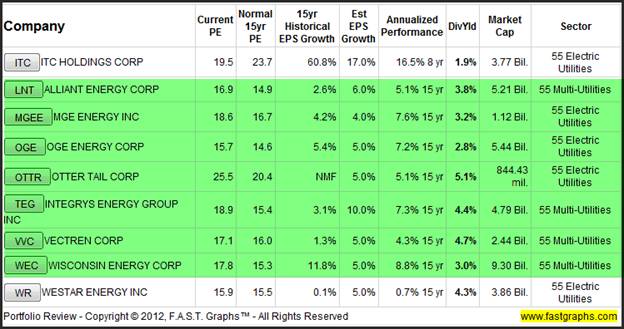
ITC Holdings Corp: Only Investor-Owned Transmission Utility
About ITC Holdings Corp. – Directly from their website
“ITC Holdings Corp. (NYSE: ITC) is the nation's largest independent electric transmission company. Based in Novi, Michigan, ITC invests in the electric transmission grid to improve reliability, expand access to markets, lower the overall cost of delivered energy and allow new generating resources to interconnect to its transmission systems. ITC's regulated operating subsidiaries include ITCTransmission, Michigan Electric Transmission Company, ITC Midwest and ITC Great Plains. Through these subsidiaries, ITC owns and operates high-voltage transmission facilities in Michigan, Iowa, Minnesota, Illinois, Missouri, Kansas and Oklahoma, serving a combined peak load exceeding 26,000 megawatts along 15,000 circuit miles of transmission line. Through ITC Grid Development and its subsidiaries, the company also focuses on expansion in areas where significant transmission system improvements are needed.”
Electric transmission is getting more focus and attention as a concept of an electronic grid analogous to the Internet. Currently there is only one investor-owned utility that is solely invested in transmission; ITC Holdings. The company was formed in 2002 when it acquired the transmission assets of DTE Energy. The company continues to buy the transmission assets from other utilities and is also building its own projects. ITC went public in July of 2005.
I look at this company separately because not only is it unique within the electric utility industry, but the investment dynamics underpinning this company are unique as well. However, notice that the 60.8% earnings growth rate is skewed due to anomalous earnings growth from 2004 to 2005. This is a classic example of how statistics can be misleading. Moreover, we further see an example of where the normal PE ratio is more meaningful than the orange earnings justified valuation line, again, due to the skewed growth rate.
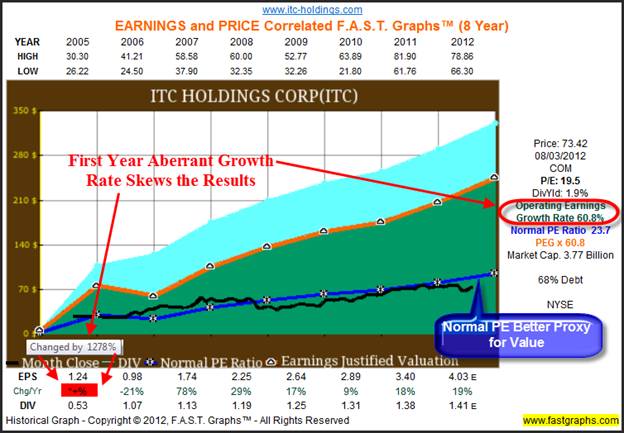
Therefore, in order to get a more reasonable and accurate picture of ITC Holding Corp.’s growth, I have re-drawn the graph from 2006 to current in order to exclude the aberrant number. With this shorter graph we discover that ITC Holdings Corp. has grown earnings substantially faster than the average regulated utility. To get an even clearer picture of this, the reader can examine the Chg/Yr column at the bottom of the graph.
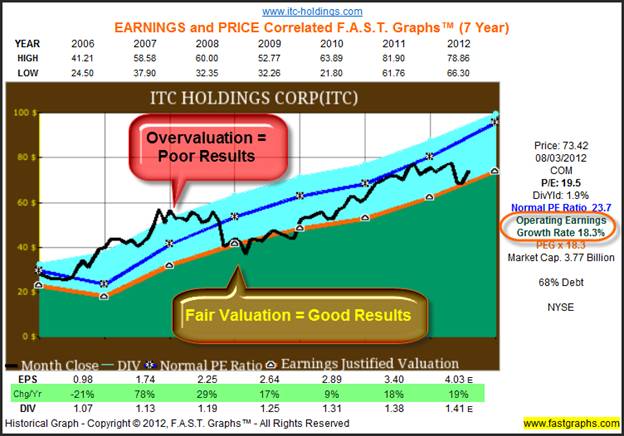
When you examine the performance associated with the above earnings and price correlated graph, you find returns that correlate with earnings growth. Consequently, ITC Holdings Corp. looks and performs more like a growth stock than a conservative utility.
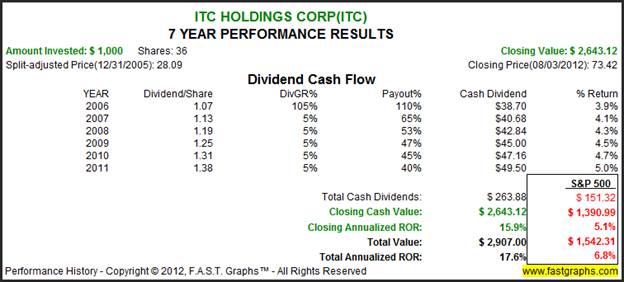
MGE Energy Inc (MGEE): Overvalued Example
About MGE Energy Inc – Directly from their website
“MGE Energy is a public utility holding company. Its principal subsidiary, Madison Gas and Electric generates and distributes electricity to 139,000 customers in Dane County, Wis., and purchases and distributes natural gas to 144,000 customers in seven south-central and western Wisconsin counties. MGE's roots in the Madison area date back more than 150 years.”
MGE Energy Inc. appears to be a classic example of what you would expect a regulated utility to look like. The company’s average earnings growth rate has been slightly higher than 4% per annum. However, a closer examination of the company’s Chg/Yr illustrates more inconsistencies than the picture implies. But most importantly, MGE Energy Inc. is clearly overvalued relative to historical norms.
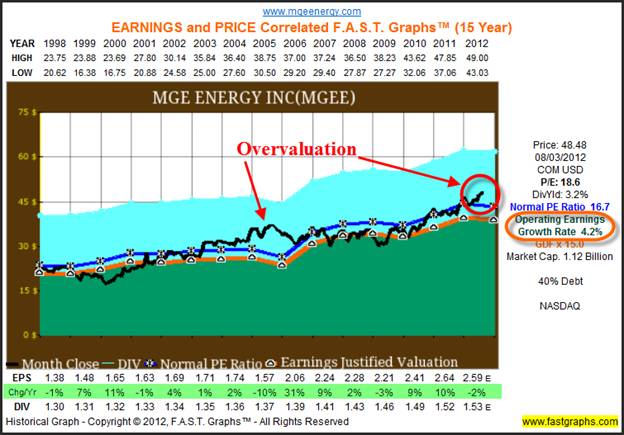
From a performance perspective, MGE Energy Inc. (MGEE) has generated returns consistent with its operating record. Capital appreciation has closely approximated earnings growth at a slight premium due to current overvaluation. Although the company has consistently increased its dividend, the growth rate of their dividend has been rather anemic.
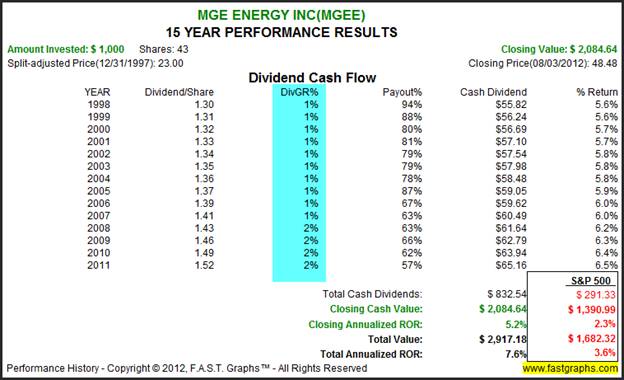
When you look at earnings forecasts, you discover that only one analyst is reporting on this company. A cross-check with Zacks also shows only one analyst. This in itself is a red flag; however, the 4% estimated growth rate is at least in line with the company’s historical achievement.
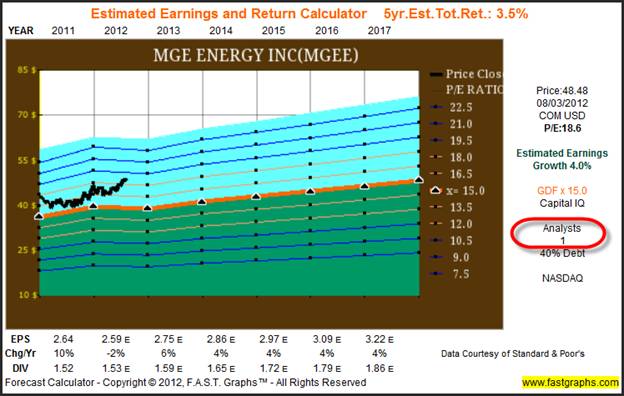
Vectren Corp. (VVC)
About Vectren Corp. – Directly from their website
“Vectren Corporation (NYSE: VVC) is an energy holding company headquartered in Evansville, Ind. Vectren's energy delivery subsidiaries provide gas and/or electricity to more than 1 million customers in adjoining service territories that cover nearly two-thirds of Indiana and west central Ohio. Vectren's nonutility subsidiaries and affiliates currently offer energy-related products and services to customers throughout the U.S. These include infrastructure services, energy services, coal mining and energy marketing.”
Vectren Corp provides yet another example of a low growth utility stock. The reader should notice that stock price has been relatively flat (see annual highs and lows highlighted in yellow) and has followed earnings since 1998. Clearly, and as we will soon see, investing in Vectren Corp is all about the dividend, as capital appreciation is extremely low. Moreover, the company is clearly fully valued as it currently sits at its historically normal PE ratio. Consequently, an argument could be made that the company is too expensive to invest in it at this time, even though it is not excessively overvalued.
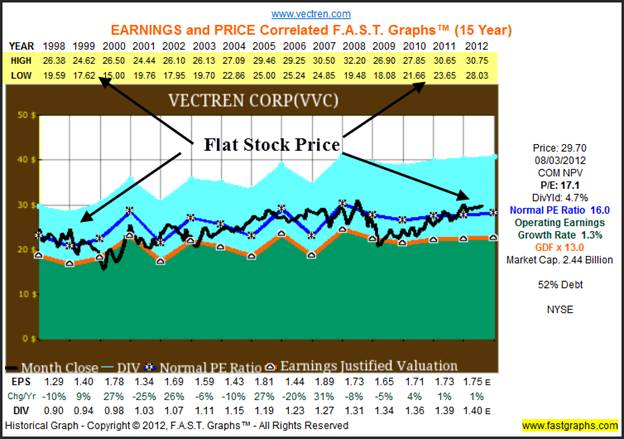
When we more closely examine Vectren Corp’s performance, we discover exactly what we might expect. Capital appreciation is closely correlated with earnings growth, and the dividend growth rate is low but consistent. Clearly, this is a utility that you buy for the dividends, but you should be very careful what price you pay to buy it at.
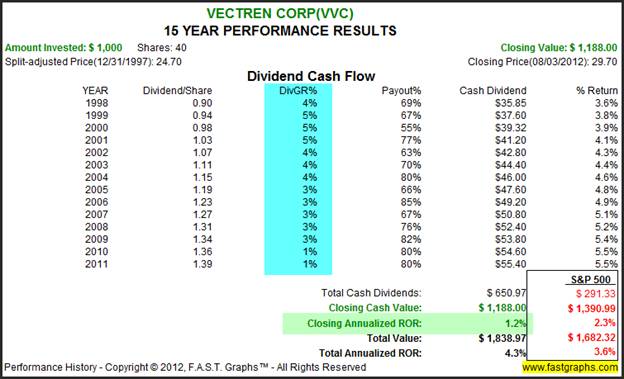
Alliant Energy (LNT)
About Alliant Energy – Directly from their website
“Alliant Energy Corporation is an energy holding company. Providing Midwest utility customers with safe and reliable electric and natural gas services is our top priority.
Our corporate headquarters are located in Madison, Wisconsin. General offices are located in Cedar Rapids and Dubuque, Iowa; utility operation facilities are located in communities throughout our utility service territory in Iowa, Minnesota and Wisconsin.”
Alliant Energy shows an almost perfect example of the earnings and price relationship. Although the company’s earnings have been moderately cyclical, the company’s stock price tracks the earnings very closely. But more importantly, we see that the company’s fair value calculated PE ratio of 15 almost perfectly correlates with its historical normal PE of 14.9. Therefore, a rather straightforward argument that the company is overvalued at its current PE ratio is vividly portrayed.

When we calculate performance associated with the above graph on Alliant Energy (LNT) we discover that capital appreciation correlates almost perfectly to earnings growth. Also, note that the company was slightly overvalued both at the beginning of this time period as well as currently. But perhaps the most important piece of information on this performance graph is the 50% dividend cut in 2003.
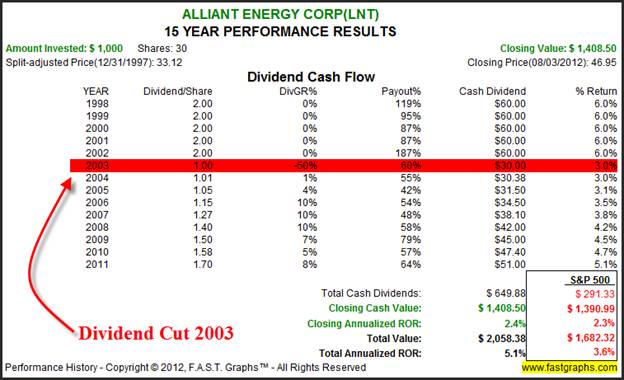
Summary and Conclusions
As we continue our examination of the utility sector, it is becoming eminently clear that the majority of utility stocks are currently fully valued. Although this is not to say that they are excessively overvalued, we must not forget that the concept of valuation is exaggerated when considering utilities. Because of very low growth rates that most of them possess, even slight overvaluation can relegate returns to below optimal levels. Therefore, we suggest that prospective investors proceed with caution and carefully examine each company that they may be contemplating. In general, utility stocks are not high risk, and are known for high yields. However, they are not known for high growth of either capital or dividends. Once again, we strongly suggest caveat emptor.
Disclosure: No positions at the time of writing.
D Disclosure: No positions at the time of writing.By Chuck Carnevale
Charles (Chuck) C. Carnevale is the creator of F.A.S.T. Graphs™. Chuck is also co-founder of an investment management firm. He has been working in the securities industry since 1970: he has been a partner with a private NYSE member firm, the President of a NASD firm, Vice President and Regional Marketing Director for a major AMEX listed company, and an Associate Vice President and Investment Consulting Services Coordinator for a major NYSE member firm.
Prior to forming his own investment firm, he was a partner in a 30-year-old established registered investment advisory in Tampa, Florida. Chuck holds a Bachelor of Science in Economics and Finance from the University of Tampa. Chuck is a sought-after public speaker who is very passionate about spreading the critical message of prudence in money management. Chuck is a Veteran of the Vietnam War and was awarded both the Bronze Star and the Vietnam Honor Medal.
© 2012 Copyright Charles (Chuck) C. Carnevale - All Rights Reserved Disclaimer: The above is a matter of opinion provided for general information purposes only and is not intended as investment advice. Information and analysis above are derived from sources and utilising methods believed to be reliable, but we cannot accept responsibility for any losses you may incur as a result of this analysis. Individuals should consult with their personal financial advisors.
© 2005-2022 http://www.MarketOracle.co.uk - The Market Oracle is a FREE Daily Financial Markets Analysis & Forecasting online publication.



